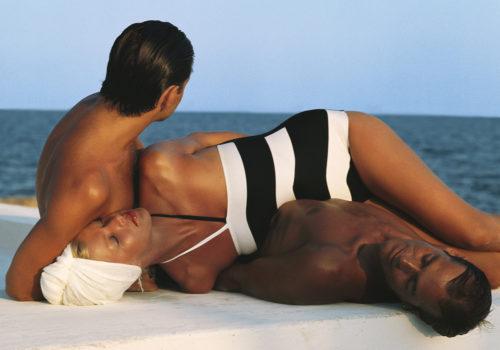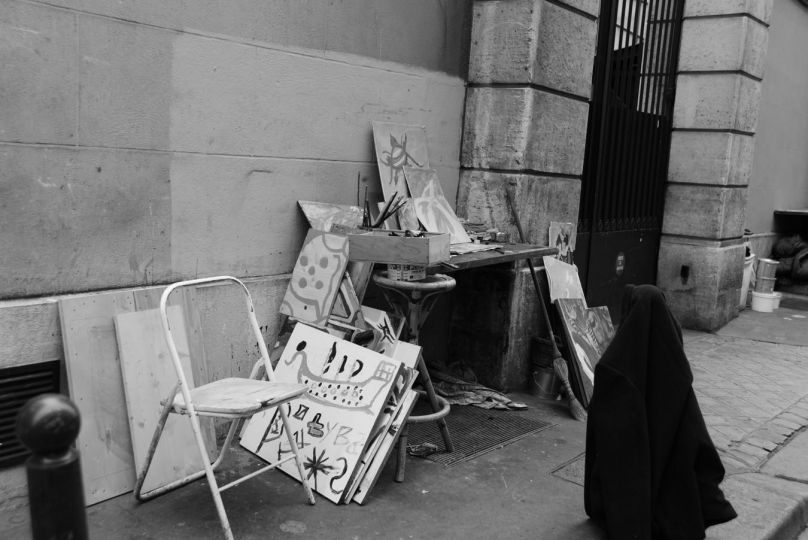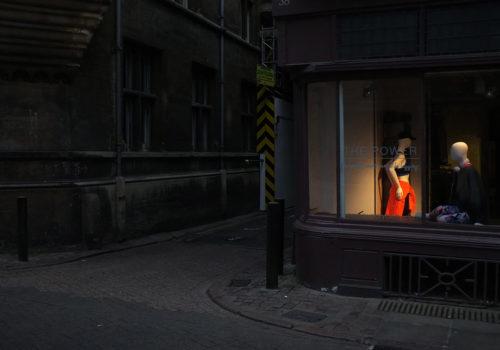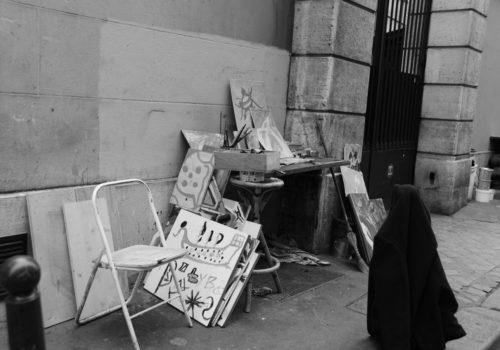Jean Daniel Lorieux: A different way of looking at things
An entire era emblematic photographer, Jean-Daniel Lorieux followed in the footsteps of artists such as Helmut Newton and Guy Bourdin. While the latter and others such as Sieff and Bailey worked in a studio and in black and white, Jean-Daniel chose, against all trends, the most beautiful outdoor sites on the planet, the light and sun of the South Seas. He tamed icons, nymphs and naiads on the golden beaches of the Bahamas, Seychelles and Maldives. His reputation quickly spread internationally, and he became best known for his sun-drenched images, which became his signature style. He loves glitz and glamour, flamboyant settings, beautiful women, incredible locations, contrasting colors and the sea… never far away.
Over the years, and for more than twenty years, he has collaborated with the most prestigious fashion magazines and the greatest couturiers, producing shoots that were akin to cinema super-productions. Helicopters, aircraft carriers, the privatization of theaters and castles – the photographer spared no expense.
He also shot the advertising campaigns of many luxury houses, including Cardin, Dior, Lanvin, Paco Rabanne and Céline, not to mention Jacques Chirac’s poster campaign for the 1988 legislative elections.
His images are like fantastic bubbles out of time, moments tinged with a chic, joyful eroticism where humor plays an important role.
He loves action, beauty and, above all, arousing desire and laughter, in order to create a beautiful image that brings joy. And he’s always happy, whatever happens, because for him, going through difficult times gives you strength!
He likes to admire others, whether Richard Avedon, whose elegance he loved, Helmut Newton, whom he knew well, or Guy Bourdin, who had immense talent, all were always very inspiring to him.
After meeting Warhol in New York, he took up painting, using the painter’s technique of taking a photo and outlining it with paint or pencil. In this way, he successfully reinterpreted his photos, establishing himself in the art world as a pop-art portraitist.
An indefatigable storyteller, his creative fibers stem from humor, beauty and action.
He was made a chevalier dans l’Ordre des Arts et des Lettres by Philippe Douste-Blazy in 1997, awarded the Légion d’honneur by Jacques Chirac in 2003, and the Médaille du Maintien de l’Ordre for his two years’ service during the Algerian war.
His work is exhibited all over the world, but mainly in the United States and Europe.
Instagram: jeandaniellorieux
Website: https://www.jeandaniellorieux.com
How did you first become interested in photography?
Jean-Daniel Lorieux: In my day, there were few activities to keep us entertained, and photography was one of them. At the time, however, I had no intention of making a career out of it. I had rather intended to become an engineer at the Jesuit Arts et Métiers. But when I returned from the Algerian war feeling so lucky to have made it back alive and well, my desires for the future were no longer the same. The things I had seen and experienced left a deep impression on me. I could no longer see myself working as an engineer. So I went to spend a weekend in the château of a friend of my mother’s, who told us that a few days later she was going to photograph Jean Gabin. I discovered then that the lady was none other than Cosette Harcourt, who asked me to come and assist her. It was an incredible experience. But although I realized how lucky I’d been to work at the Harcourt Studio, after what I’d just been through, I was craving light and sunshine. What’s more, I’ve always admired women, and my encounter with a pretty Danish model made me want to get into fashion. That’s how I got into photography.
The man or woman in the picture who inspires you?
Jean-Daniel Lorieux: I was lucky enough to see Avedon in Paris during one of his shoots. The man was elegant, and the work went on in good spirits. It confirmed to me that this was what I wanted to do. Seeing the covers of Vogue and Harper’s Bazar, they all showed women laughing and making you dream. All this motivated me to become a fashion photographer.
Pierre Cardin was also very inspiring, and in a way, he gave me my first opportunity by entrusting me with one of his campaigns, without even knowing what I was capable of doing.
The one that moved you the most?
Jean-Daniel Lorieux: Many images have moved me and made me want to do this job. Among them, Avedon of course, Guy Bourdin and the brilliant Hiro.
And the one that made you angry?
Jean-Daniel Lorieux: Photos never make me angry. They express something. So, of course, in some cases, the subject can make you angry, but certainly not the image.
A photographic memory from your childhood?
Jean-Daniel Lorieux: All the family photos I took at Harcourt.
A photographic memory from your childhood?
Jean-Daniel Lorieux: All my family photos taken at Harcourt Studio.
With no budget limit, what work of art would you dream of acquiring?
Jean-Daniel Lorieux: Although I was brought up in an environment where classical painting was king, my choice this time would be a Warhol.
What do you think makes a good photographer?
Jean-Daniel Lorieux: It all depends on the photographic niche, but in general I think it’s necessary, especially in fashion, to convey joy and good humor with style. Life is more and more difficult, it’s a constant battle, so if as a photographer we can give a little happiness, it seems essential to me.
What do you think is the difference between the photography you started out with and the photography we do today?
Jean-Daniel Lorieux: When I started out, I spent three weeks a month in the four corners of the world, photographing the most beautiful women in the most wonderful places. We had the time and, above all, the budget. Today, everything is done in a hurry, often with ridiculous budgets.
What is the secret of the perfect image, if it exists?
Jean-Daniel Lorieux: Of course, there’s no such thing as the perfect image. There are those that touch and move you, and then there are the others.
Who would you like to photograph if you could?
Jean-Daniel Lorieux: The list of people I’d like to photograph is very long, even though it’s not my favorite thing to do. Nevertheless, I’d love to do another photoshoot with Mick Jagger, whom I admire greatly and whom I was lucky enough to photograph in his early days.
An essential photo book?
Jean-Daniel Lorieux: Spontaneously, I’d say one of the books about Hiro’s work. But there are also many other very fine books.
Your childhood camera?
Jean-Daniel Lorieux: FOCA
The one you use today?
Jean-Daniel Lorieux: The ones I have the chance to get. (Laughs)
What’s your favorite drug?
Jean-Daniel Lorieux: Laughter.
What’s the best way to switch off?
Jean-Daniel Lorieux: To arrive at the beach.
What is your personal relationship with images?
Jean-Daniel Lorieux: I’d rather be behind the lens than in front of it.
What’s your greatest quality?
Jean-Daniel Lorieux: Losing my memory.
Your latest folly?
Jean-Daniel Lorieux: I’ve had a lot. So maybe waking up again every morning (whether alone or in charming company) seems like a folly to me.
An image to illustrate a new banknote?
Jean-Daniel Lorieux: Andy Warhol’s Dollar.
What job would you rather not have?
Jean-Daniel Lorieux: Engineer
And if you hadn’t been a photographer, what would you have done for a living?
Jean-Daniel Lorieux: My dream would have been to become a film director.
Your greatest professional extravagance?
Jean-Daniel Lorieux: Without hesitation, I’d say it was illustrating and filming Mikhail Bulgakov’s Russian masterpiece “The Master and Margarita”, with the delightful Isabelle Adjani in the role of Margarita. It’s by far my most expensive production.
Where do you think photography ends and art photography begins?
Jean-Daniel Lorieux: That’s a difficult question to answer. The boundary between the two is very complex. What is art and what is not?
An art photo must show originality, there must be something special going on, something that may or may not have been prepared for, I’d say. As far as I’m concerned, I’ve never pretended to be an art photographer. I’ve just been lucky that certain people like my work and that it’s been exhibited in certain galleries around the world.
Which city, country or culture do you dream of discovering?
Jean-Daniel Lorieux: Tetiaroa, the main island of Tahiti, once owned by Marlon Brando.
The place you never tire of?
Jean-Daniel Lorieux: Any beach.
Your biggest regret?
Jean-Daniel Lorieux: Not having had the chance to work with some of the top models of the 90s like Tatyana Patitz, Jerry Hall or Helena Christiansen.
In terms of social networks, do you prefer Instagram, Facebook or Tik Tok, and why?
Jean-Daniel Lorieux: I leave that to my teams.
Color or B&W?
Jean-Daniel Lorieux: Color of course.
Daylight or artificial light?
Jean-Daniel Lorieux: Daylight, but very sophisticated.
What’s the most photogenic city in your opinion?
Jean-Daniel Lorieux: Venice.
If God existed, would you ask him to pose for you, or would you opt for a selfie with him?
Jean-Daniel Lorieux: I’d ask him to pose, of course.
If I could organize your ideal dinner party, who would be at the table?
Jean-Daniel Lorieux: It would be a picnic on the beach with Jean Marais, Jean Cocteau, Isabelle Adjani, Pierre Cardin, Paco Rabanne, Azzedine Alaïa, Richard Avedon, Hiro, Picasso, David Hockney, Wahrol, Jean Dormesson, Françoise Sagan… and so many others that one dinner wouldn’t be enough.
Which image do you think represents the current state of the world?
Jean-Daniel Lorieux: The image that comes to mind is the one of clouds in front of the sun.
What do you think is missing in today’s world?
Jean-Daniel Lorieux: As life becomes more difficult and combative, the world no longer laughs enough.
If you had to do it all over again?
Jean-Daniel Lorieux: I’d do it all over again without a second thought.
Any last words?
Jean-Daniel Lorieux: More than yesterday and less than tomorrow!
















